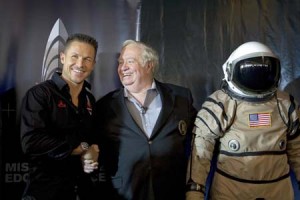Sound Barrier Buster
On August 16, 1960, U.S. Air Force Captain Joe Kittinger stepped out of the gondola of a balloon at 102,800 feet above New Mexico wearing a pressure suit. In the thin air, he accelerated to 614 miles an hour in free fall before denser atmosphere slowed his plunge to a speed that allowed him to open…
On August 16, 1960, U.S. Air Force Captain Joe Kittinger stepped out of the gondola of a balloon at 102,800 feet above New Mexico wearing a pressure suit. In the thin air, he accelerated to 614 miles an hour in free fall before denser atmosphere slowed his plunge to a speed that allowed him to open a parachute.
Those altitude and speed records, which have stood for a lifetime by some countries' life expectancy tables, may soon fall.
The challenger, Austrian pilot Felix Baumgartner, announced his project, Red Bull Stratos, in New York last Friday. He plans an attempt to break Kittinger's record later this year with a jump from a balloon at 120,000 feet. Baumgartner should exceed 690 miles an hour—at more than Mach 1, the first person ever to break the sound barrier in free fall—before parachuting to the ground. His backers Red Bull, Microsoft, Nokia, and Riedel Communications have deep pockets and a history of getting things done, so it would seem that if there's any chance of breaking Kittinger's record, which was financed and conducted by the U.S. Air Force, this is it.

No one is bubbling with more excitement than Kittinger, 81. "People have been trying to break my records for fifty years, and many have died in the attempt," he said Friday on the 40th floor of a New York skyscraper where the project was being unveiled. "But I believe that with our unique assets, an extraordinary mission team, the dedication of Red Bull, and Baumgartner's outstanding skills, Reb Bull Stratos will succeed."
British stuntman Steve Truglia has been saying for years that he'll be the next daredevil to break Kittinger's record, along with others including Frenchman Michel Fournier and American Cheryl Stearns. Their attempts have been foiled by lack of finances, good weather, and plain luck.
Baumgartner says it won't be a breeze. "This is truly a step into the unknown," he said. "No one can accurately predict how the human body will react in the transition to supersonic speeds. But we've got to find out. Future aerospace programs need a way for pilots and astronauts to bail out at high altitude in case of emergency."
Those altitude and speed records, which have stood for a lifetime by some countries' life expectancy tables, may soon fall.
The challenger, Austrian pilot Felix Baumgartner, announced his project, Red Bull Stratos, in New York last Friday. He plans an attempt to break Kittinger's record later this year with a jump from a balloon at 120,000 feet. Baumgartner should exceed 690 miles an hour—at more than Mach 1, the first person ever to break the sound barrier in free fall—before parachuting to the ground. His backers Red Bull, Microsoft, Nokia, and Riedel Communications have deep pockets and a history of getting things done, so it would seem that if there's any chance of breaking Kittinger's record, which was financed and conducted by the U.S. Air Force, this is it.

No one is bubbling with more excitement than Kittinger, 81. "People have been trying to break my records for fifty years, and many have died in the attempt," he said Friday on the 40th floor of a New York skyscraper where the project was being unveiled. "But I believe that with our unique assets, an extraordinary mission team, the dedication of Red Bull, and Baumgartner's outstanding skills, Reb Bull Stratos will succeed."
British stuntman Steve Truglia has been saying for years that he'll be the next daredevil to break Kittinger's record, along with others including Frenchman Michel Fournier and American Cheryl Stearns. Their attempts have been foiled by lack of finances, good weather, and plain luck.
Baumgartner says it won't be a breeze. "This is truly a step into the unknown," he said. "No one can accurately predict how the human body will react in the transition to supersonic speeds. But we've got to find out. Future aerospace programs need a way for pilots and astronauts to bail out at high altitude in case of emergency."